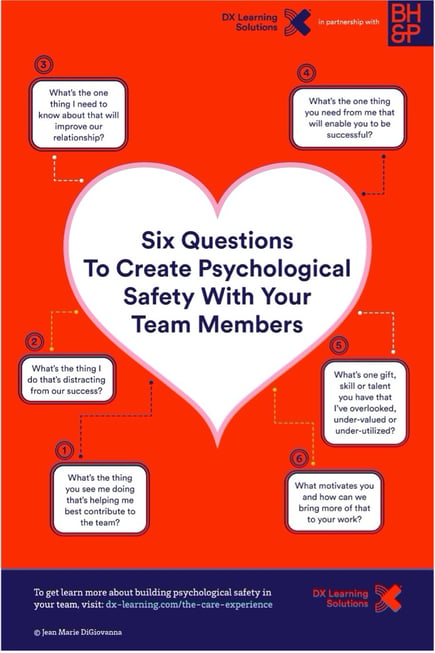Let's Talk Leadership - Keeping the Good Ones

What’s one of the biggest problems in workplaces right now? Retention.
If you’re a leader, think of the indispensable people on your team right now. The ones you rely on the most to get the results you need, keep the team engaged and are a core asset to the team. Got them identified?
Okay. How would you feel if they quit tomorrow?
I can guarantee replacing them would be just as painful as losing them.
Businesses are people, and people aren’t perfect.
Effective teams are simply the sum of all their imperfect parts and are only ever as strong as their weakest member.
The best teams, the ones we remember and revere, work hard to ensure they continually develop those imperfections, and provide equity, ensuring those that need time, energy, and resources get what they need. That “we” versus “me” mindset.
Great teams are brought together by a common purpose, a shared set of values and clear expectations. A common understanding that defines why they do what they do, who does what, and how things get done in a consistent manner. A culture.
The question is how do you keep a good one, if you don’t know what a good one looks like?
What do the Stats Say?
People want to be associated with companies that have a strong sense of purpose. Who contribute to societal well-being and are driven for the greater good.
These values must be reinforced by a company (or team) culture to be able to work, and it’s incumbent upon an organization to build a healthy culture for everyone. To create a human-centric workplace that shapes the individual employee experience.
It doesn’t just happen naturally.
Let's start with what the data says.
According to Zippia Statistics:
- The national average annual turnover rate in the United States was 57.3% in 2020.
- The number of people who left their job due to quitting, layoffs, discharges, or any other separation, increased to 6.2 million people in September 2021.
- Companies lose 18% of their workforce to turnover each year, on average. 12% of this is voluntary, and 6% is involuntary (layoffs, terminations, etc.)
- In 2018, the overall cost of voluntary employee turnover amounted to $617 billion.
So, what exactly is a good attrition rate?
According to Apollo Technical, companies should be aiming for 90% or higher retention rates with a turnover rate of 10% or less. Now you know. 10 is the magic number.
Where are you right now in relation to the magic number?
How do we Keep the Good Ones?
Firstly, identify who the good ones are.
To identify your best employees, ask yourself these questions.
Do they:
- Add something different to the team?
- Work well with other team members?
- Act with just the right autonomy?
- Ask questions, especially around clarity?
- Take ownership of their results and help others do so?
- Collaborate effectively and always present?
- Challenge the status quo?
- Display selflessness and not selfishness?
- Do more than what's expected?
- Demonstrate the team’s core values and behaviors?
- Drive the team forward?
- Demonstrate the we versus I attitude?
- Speak up in meetings?
- Call you out on your bullshit?
If you answer yes to most of these questions, you have got yourself an employee worth keeping. This type of employee matters, to you and to the company. They are a good one worth keeping.
Embracing Imperfections
“A team of people is the sum of the imperfections of that team”
OR
“A team is only as good as its weakest team member.”
Imperfections within individuals team members can be a key factor into driving the downfall of performance. We are human and humans are beautifully imperfect. That means we can endlessly improve.
An effective leader is one who can build a diverse and dispersed team, adapt to their surroundings and, most importantly, connect and have empathy for all those they serve, allowing others to be uplifted and guided toward the path of success and fulfilment.
A leader knows the imperfections of their team, and themselves, and works tirelessly to develop them. You can’t change what you don’t know needs to change, and great leaders spend the time finding out exactly what that is.
“I define a leader as anyone who takes responsibility for finding the potential in people and processes, and who has the courage to develop that potential.”
― Brené Brown
As humans, of course we are all imperfect. That’s why we can’t all be left to our own devices because it’s ineffective. We all do what we think is right, which isn’t always right, and unless we are told do more of this, or less of that, we just continue doing things our way. That’s why leaders must find the time to ensure they connect, learn, and develop their team.
Everyone has their imperfections. It’s all part of the journey towards working up the career ladder, business growth, and gaining relevant work experience. As that grows, autonomy can grow.
The Role of a Leader
A leader has many responsibilities.
It sometimes seems impossible to do it all.
Of course, a great leader knows they aren’t a hero, so they will seek out support – a wing-person in other words –to have the extra help to continue supporting the growth and development of the team.
That wing-person is known as our “good one”, the employee we don’t want to lose. We can’t afford to lose them.
Why are the Good Ones Leaving?
Firstly. It's most likely not about the money.
(I say that with this caveat. If you are not getting a fair pay for the work you do, it is about the money. But let’s assume you are getting paid fairly.)
There is an endless list of reasons that factor into an employee leaving.
But, to keep one top of mind, research shows it’s most likely a toxic culture.
“A toxic culture is 10.4x more likely to contribute to attrition than compensation.”
- (J. Sockin)
MIT Sloan research found a toxic culture is contributed by these factors:
- Failure to promote diversity, equity, and inclusion
- Workers feeling disrespected
- Unethical behavior
The key message is that good people don't want to work for bad bosses.
Good people don't want to work for toxic cultures. A culture is a mirror of leadership, and leadership is how a leader thinks and behaves. Bad bosses drive out the good ones in a talent-driven market.
Good people want a sense of belonging, and inclusiveness, and they will be transient until they find it.
Good people are more than likely to take a pay decrease to find a culture where they can be their true authentic selves over one where they can’t.
It all gets levelled-up by the employee’s evaluation of what they value in life and if there's a disparity between what they value, what their boss values, or what their company values. The greater the dissonance there is, the more likely they are to leave.
If it doesn’t match up. It’s game over.
“Toxic bosses > toxic cultures = Get me out of here”
Secondly. It's most likely a leadership problem.
A leader’s responsibility is to set the bar by modelling what they expect of others through their behaviors and mindset. The team culture is a mirror of them and the worst behavior they are willing to tolerate. If they have an asshole on the team who they tolerate due to the results they get, that asshole sets the culture of the team = assholey culture
At the macro-level, employees also must physically see what the CEO is saying about company values. Are CEOs and senior leaders practicing what they preach day-to-day?
If this isn’t the case, the employees are likely to be on LinkedIn looking for their next best opportunity.
How would this make you feel?
What Can a Company do to Keep the Good Ones?
- Be clear about the values as an organization and make sure empathy and inclusiveness are valued.
- Embed these values into the company culture.
- Ensure the company is living and breathing the core values through their leaders modelling the right behaviors.
- Hardwire the values into performance management.
What Can Leaders do to Keep the Good Ones?
Leaders need to step up on the plate and actually lead through empathy and inclusion.
Leaders need to keep the team and the people engaged. Keep having conversations. Keep asking questions. Stop trying to be interesting and start being curious and interested in those you serve. Lead with empathy and connect with your team. Find time to listen to them, learn about them, and see them for the humans they are.
Coaching those not living the values. Fire those who repeatedly appose the aspired culture.
Psychological safety is key to have embedded into any working culture, so teams and individuals can thrive in a healthy environment.
According to Accenture, there is a 27% reduction in turnover if you have psychological safety embedded in your teams.
And where does that start? You guessed it. With our leaders.
“Low levels of psychological safety can create a culture of silence.”
- Amy C. Edmondson
Silence kills relationships. Silence is a culture killer.
Jean Marie DiGiovanna, leadership development expert, has developed 6 key questions to help increase psychological safety within team members.
Give it a try. See what you can learn about your team.
- What’s the thing you see me doing that’s helping me best contribute to the team?
- What's the thing I do that’s detracting from our success?
- What’s one thing I need to know about you that will improve our relationship?
- What’s one thing you need from me that will enable you to be successful?
- What’s one gift, skill, or talent you have that I’ve overlooked, under-valued or under-utilized?
- What motivates you and how can we bring more of that to your work?
At DX Learning we create workplaces worth working for by creating and delivering great leadership training.
No-one was born to lead. Great leadership is learned, so we need to develop empathy and inclusiveness habits that will lead to psychological safety within your teams.
What are you waiting for?
Let’s wipe out bad leadership together. Get in touch.
Insights

Subscribe to Our Monthly Newsletter!
For managers and talent professionals who truly believe in putting people first, the CARE to Win blog is your gateway to the latest insights on human-centric leadership. Join us as we champion the people first movement.
Need some time apart? Are we emailing you too often? Just give us your feedback, and we promise we’ll respond. We really do care. And if it’s still too much, just unsubscribe. It’s cool.
.jpg) Alex Draper
Alex Draper








